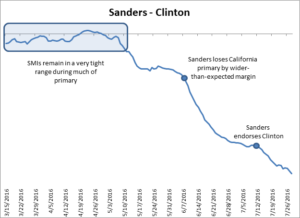Forecasting: 2016 US Presidential Election
Social Media Influence (SMI) for Bernie Sanders minus Hillary Clinton, from July 2016 Source: ZettaCap
Most pundits will openly state that the 2016 election fooled everyone. It fooled most for sure. Well-known academics, professional forecasters, and analysts had called the election for Clinton well ahead of time. Even the day before voting, the average forecasted probability of a Clinton victory was around 90%. Anyone who thought Trump had more than a slight chance was basically out of their mind, at least according to the consensus view.
ZettaCap produced copious amounts of research on the 2016 Presidential race starting from before the primaries. ZettaCap focused on social media data, using its proprietary Social Media Influence (SMI) for forecasting. Early on, it called the Republican race would go to Trump and that the Democratic race would be hard fought between Clinton and Sanders, with Clinton prevailing. At the time, these forecasts were considered unusual but ended up accurate.
As the general election began, SMI gave the edge to Trump, which again at that time was unusual. Social media based forecasts were backed up using other alternative on-line datasets such as search and Wikipedia trends. ZettaCap’s analysis of on-line data varied considerably with polls which favored Clinton. We concluded that polls were off for many reasons (for instance due to their reliance of turnout models based on previous elections and due to their overwhelming usage of live interviewers) and that in such an emotionally-charged environment, social media and on-line data would offer more accurate insights.
ZettaCap consistently pointed to Trump as the front-runner during the general election campaign. Through slews of negative headlines, protests, and polls, SMI continued to forecast Trump winning the election. We repeatedly warned of polls and forecasters being off the mark, even taking an outspoken stance stating “… the entire (forecasting) industry will get egg on its face within a month’s time (on election-day).”
ZettaCap’s final forecast was for a Trump victory with 306 electoral votes. It was the most out-of-consensus quantitatively based forecast. It would have been completely ridiculed together with SMI and other on-line forms of data analysis – if it had not been correct. Trump won with 306 electoral votes. SMI even called that Trump would win seemingly impossible states as Michigan and Pennsylvania.
The chart here, taken from our July 2016 report, shows the relative SMIs of Bernie Sanders and Hillary Clinton during the Democratic Primaries. It shows how tight the election was, at least according to SMI, until early May – when Sanders pulled off a stunning Indiana Primary upset on May 3rd. But, his relative SMI faded throughout May showing his influence declined rapidly on social media before it was apparent to most pundits. It is interesting to see how SMI was used in the primaries and not just the general election.
Important because:
- Only forecast to correctly call the 2016 US Presidential Election,
- Forecast consistently pointed to Trump victory throughout general election campaign,
- Based on a proprietary Social Media Influence (SMI) which has been successfully applied to other elections,
- Succeeded in forecasting primary results for Republicans and Democrats in addition to the general election.
